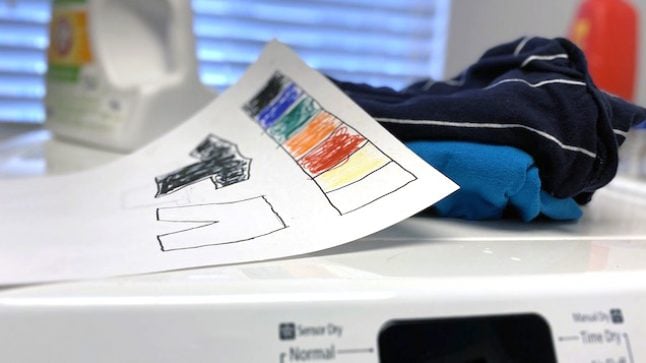Serie: Ideas at Work
Lavemos las matemáticas en el día de la colada

Whether you have a machine at home or visit a laundromat, there is all kinds of math involved in doing laundry. And there are all kinds of ways that children of all ages can join in the thinking and doing. The washing and folding will take a little longer when you involve your “little helper” but those extra minutes of math time together are worth it!
Separando La Ropa
Everyone has their own rules about sorting clothes before and after washing. They all call for logical thinking that even toddlers can understand. Here’s a few ideas about turning often what feels like a chore into math conversations and games.
Lanzamiento de ropa: Put out one basket for light colors and a second one for dark colors. Let everyone take turns tossing an item from the pile of dirty clothes into the correct basket. With toddlers, cheer and give a shout out that names the rule: YAY you got your light blue shirt into the Lights basket! You might do this as a kind of bean bag game—you get 2 points for tossing an item into the correct basket; only one point if it doesn’t quite make into the basket.

Emparejamiento
Two-year-old children will enjoy finding and creating a pile of their own clothes. By the age of 3 many children are able to match socks — for themselves and others. Chat about the math, noticing and asking them about how they make a match. Older children can sort in more complex ways such as pajamas and school clothes or even type of clothing and family member who wears it.
Doblar y Apilar
Children ages 3 and up often enjoy folding flat items such as towels — and can get quite good at it. Lining up the corners lets children explore symmetry. As children get older, the conversations can get more elaborate. This video shows a great math conversation about shapes, colors, and fractions.
Predecir
Antes de separar la ropa, anime a que los niños predigan cual canasta tendrá más ropa y que le expliquen por qué creen eso. Después separen la ropa y comparen los resultados con la predicción y conversen al respecto.
Hagan Comparaciones
A medida que los niños se hacen mayores hay varias maneras de representar el conteo de la ropa usando marcas de conteo o graficas. Estas manera de llevar la cuenta permite tener conversaciones acerca de las diferente cantidad de cada ropa en comparación a otra.
- Use marcas de conteo para llevar la cuenta de cuantos calcetines, camisas etcétera, hay o quien tiene más ropa para lavar o doblar hoy. Hay muchas comparaciones que se pueden hacer: ¿Qué tipo de ropa es la más común? ¿Cuál montón de ropa doblada es el más alto? ¿Por qué el montón de pantalones de mezclilla es más grande/alto que el montón de camisas a pesar de que la cantidad de camisas es mayor que la cantidad de pantalones de mezclilla?
- Guarde la información recopilada con las marcas de conteo o la gráfica y úsela para predecir y comparar con lo que ocurre la siguiente vez que laven la ropa. Los niños de primer y segundo grado pueden querer convertir las marcas de conteo en graficas de barras o de dibujos.